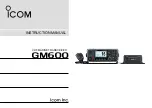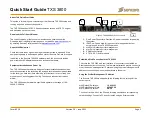
65-2405RK-04 Combustible Gas Transmitter • 3
Combustible Gas Detector
The combustible gas detector is a catalytic type detector that produces an electrical output
that corresponds to the detection range. It is packaged in a 1/2 inch NPT nipple with a
sintered metal flame arrestor on one end allowing ambient air to diffuse into the detector.
The flame arrestor also contains any sparks which may occur within the detector. The 1/2
inch NPT mounting threads at the top of the detector allow you to mount it into the
bottom conduit hub of the junction box. A rainshield screws onto the bottom of the
detector (flame arrestor end). The rainshield helps protect the detector from rain and
debris in the monitoring environment. Four color-coded leads extend from the top of the
detector. The leads allow you to connect the detector to the amplifier.
Calibration Cup/Splash Guard
A calibration cup/splash guard is installed on the rainshield of the combustible gas
detector. A fitting at the bottom of the calibration cup/splash guard allows a length of
tubing to be connected for calibration and routed to a more easily accessible location. The
calibration cup/splash guard also protects the detector.
Amplifier
The amplifier is located in the amplifier junction box. The amplifier converts the electrical
output from the detector to a 4 to 20 mA signal that corresponds to the detection range
and transmits the signal to a gas monitoring controller. A foam gasket that orients the
amplifier and keeps it from rotating is installed on the bottom of the amplifier. A label on
the amplifier indicates the detector drive current. This drive current is factory set and is
dictated by the combustible gas to which the detector is calibrated. Consult RKI
Instruments, Inc. if you plan to change the calibration gas for the transmitter, for example
from a methane calibration to a hexane calibration. The amplifier includes the detector
terminal strip, controller terminal strip, span pot, zero pot, and test points (see Figure 1).
Controller Terminal Strip
The controller terminal strip is a three position plug-in style terminal strip located near the
top of the amplifier. Use the controller terminal strip to wire the combustible gas
transmitter to a controller.
Detector Terminal Strip
The detector terminal strip is a four position plug-in style terminal strip located below the
controller terminal strip. Use the detector terminal strip to connect the combustible gas
detector to the amplifier.
NOTE:
See “Wiring the Detector to the Amplifier” on page 6 for all wiring procedures
related to the transmitter.
Zero Pot
The zero pot is located in the upper left corner of the amplifier (see Figure 1). Use a small
flat blade screwdriver to turn the zero pot’s adjustment screw and adjust the amplifier’s
zero (fresh air) output during the start-up and calibration procedures. Turn the adjust-
ment screw clockwise to increase the zero output and counterclockwise to decrease the
zero output.
Span Pot
The span pot is located to the right of the zero pot (see Figure 1). Use a small flat blade
screwdriver to turn the span pot’s adjustment screw and adjust the amplifier’s gas
response output during the calibration procedure. Turn the adjustment screw clockwise to
www.
.com
1.800.561.8187








































